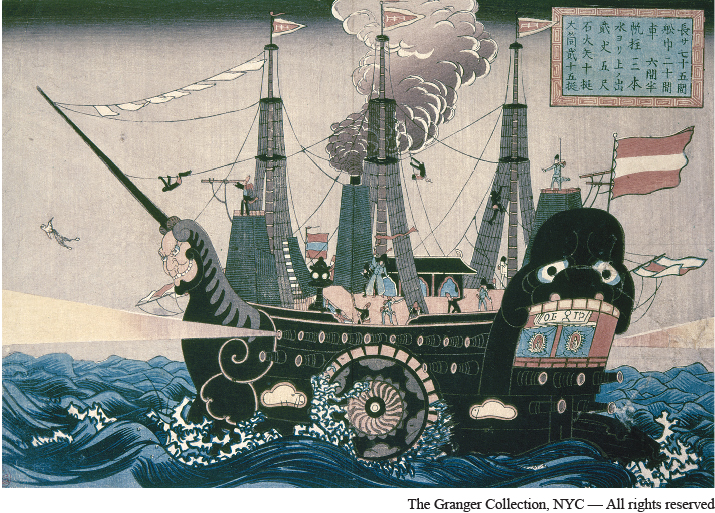American Intrusion and the Meiji Restoration
AP® EXAM TIP
The rise of the United States as a world power is an important concept in AP® World History.
It was foreign intervention that brought matters to a head. Since the expulsion of European missionaries and the harsh suppression of Christianity in the early seventeenth century (see “Asians and Asian Commerce” in Chapter 14), Japan had deliberately limited its contact with the West to a single port, where only the Dutch were allowed to trade. By the early nineteenth century, however, various European countries and the United States were knocking at the door. All were turned away, and even shipwrecked sailors or whalers were expelled, jailed, or executed. As it happened, it was the United States that forced the issue, sending Commodore Perry in 1853 to demand humane treatment for castaways, the right of American vessels to refuel and buy provisions, and the opening of ports for trade. Authorized to use force if necessary, Perry presented his reluctant hosts with, among other gifts, a white flag for surrender should hostilities follow.

In the end, the Japanese avoided war. Aware of what had happened to China as a result of resisting European demands, Japan agreed to a series of unequal treaties with various Western powers. That humiliating capitulation to the demands of the “foreign devils” further eroded support for the shogunate, triggered a brief civil war, and by 1868 led to a political takeover by a group of young samurai from southern Japan. This decisive turning point in Japan’s history was known as the Meiji (MAY-jee) Restoration, for the country’s new rulers claimed that they were restoring to power the young emperor, then a fifteen-year-old boy whose throne name was Meiji, or Enlightened Rule. Despite his youth, he was regarded as the most recent link in a chain of descent that traced the origins of the imperial family back to the sun goddess Amaterasu. Having eliminated the shogunate, the patriotic young men who led the takeover soon made their goals clear — to save Japan from foreign domination not by futile resistance, but by a thorough transformation of Japanese society drawing on all that the modern West had to offer. “Knowledge shall be sought throughout the world,” they declared, “so as to strengthen the foundations of imperial rule.”
AP® EXAM TIP
You should know the features of the Meiji Restoration.
Japan now had a government committed to a decisive break with the past, and it had acquired that government without massive violence or destruction. By contrast, the defeat of the Taiping Uprising had deprived China of any such opportunity for a fresh start, while saddling it with enormous devastation and massive loss of life. Furthermore, Japan was of less interest to Western powers than either China, with its huge potential market and reputation for riches, or the Ottoman Empire, with its strategic location at the crossroads of Asia, Africa, and Europe. The American Civil War and its aftermath likewise deflected U.S. ambitions in the Pacific for a time, further reducing the Western pressure on Japan.